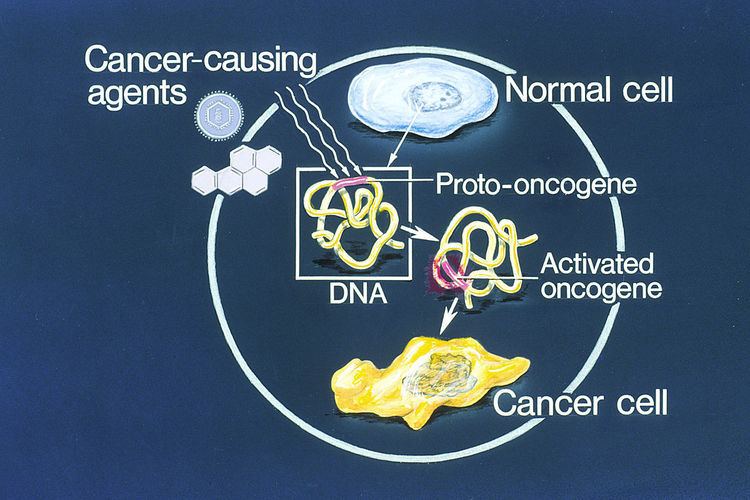 | ||
An oncogene is a gene that has the potential to cause cancer. In tumor cells, they are often mutated or expressed at high levels.
Contents
Most normal cells will undergo a programmed form of rapid cell death (apoptosis) when critical functions are altered. Activated oncogenes can cause those cells designated for apoptosis to survive and proliferate instead. Most oncogenes require an additional step, such as mutations in another gene, or environmental factors, such as viral infection, to cause cancer. Since the 1970s, dozens of oncogenes have been identified in human cancer. Many cancer drugs target the proteins encoded by oncogenes.
History
The first theory of oncogenes was given by Danish physicist Niels Henrik Arley around 1950, but was rejected by contemporaries as nonsense. Later on the term "oncogene" was rediscovered in 1969 by National Cancer Institute scientists George Todaro and Robert Heubner.
The first confirmed oncogene was discovered in 1970 and was termed src (pronounced sarc as in sarcoma). Src was in fact first discovered as an oncogene in a chicken retrovirus. Experiments performed by Dr. G. Steve Martin of the University of California, Berkeley demonstrated that the Src was indeed the oncogene of the virus. The first nucleotide sequence of v-src was sequenced in 1980 by A.P. Czernilofsky et al.
In 1976 Drs. Dominique Stehelin, J. Michael Bishop and Harold E. Varmus of the University of California, San Francisco demonstrated that oncogenes were activated proto-oncogenes, found in many organisms including humans. For this discovery, proving Todaro and Heubner's "oncogene theory", Bishop and Varmus were awarded the Nobel Prize in Physiology or Medicine in 1989.
The resultant protein encoded by an oncogene is termed oncoprotein. Oncogenes play an important role in the regulation or synthesis of proteins linked to tumorigenic cell growth. Some oncoproteins are accepted and used as tumor markers.
Proto-oncogene
A proto-oncogene is a normal gene that could become an oncogene due to mutations or increased expression. Proto-oncogenes code for proteins that help to regulate cell growth and differentiation. Proto-oncogenes are often involved in signal transduction and execution of mitogenic signals, usually through their protein products. Upon acquiring an activating mutation, a proto-oncogene becomes a tumor-inducing agent, an oncogene. Examples of proto-oncogenes include RAS, WNT, MYC, ERK, and TRK. The MYC gene is implicated in Burkitt's Lymphoma, which starts when a chromosomal translocation moves an enhancer sequence within the vicinity of the MYC gene. The MYC gene codes for widely used transcription factors. When the enhancer sequence is wrongly placed, these transcription factors are produced at much higher rates. Another example of an oncogene is the Bcr-Abl gene found on the Philadelphia Chromosome, a piece of genetic material seen in Chronic Myelogenous Leukemia caused by the translocation of pieces from chromosomes 9 and 22. Bcr-Abl codes for a tyrosine kinase, which is constitutively active, leading to uncontrolled cell proliferation. (More information about the Philadelphia Chromosome below)
Activation
The proto-oncogene can become an oncogene by a relatively small modification of its original function. There are three basic methods of activation:
- A mutation within a proto-oncogene, or within a regulatory region (for example the promoter region), can cause a change in the protein structure, causing
- an increase in protein (enzyme) activity
- a loss of regulation
- An increase in the amount of a certain protein (protein concentration), caused by
- an increase of protein expression (through misregulation)
- an increase of protein (mRNA) stability, prolonging its existence and thus its activity in the cell
- gene duplication (one type of chromosome abnormality), resulting in an increased amount of protein in the cell
- A chromosomal translocation (another type of chromosome abnormality)
- There are 2 different types of chromosomal translocations that can occur:
- translocation events which relocate a proto-oncogene to a new chromosomal site that leads to higher expression
- translocation events that lead to a fusion between a proto-oncogene and a 2nd gene (this creates a fusion protein with increased cancerous/oncogenic activity)
- the expression of a constitutively active hybrid protein. This type of mutation in a dividing stem cell in the bone marrow leads to adult leukemia
- Philadelphia Chromosome is an example of this type of translocation event. This chromosome was discovered in 1960 by Peter Nowell and David Hungerford, and it is a fusion of parts of DNA from chromosome 22 and chromosome 9. The broken end of chromosome 22 contains the "BCR" gene, which fuses with a fragment of chromosome 9 that contains the "ABL1" gene. When these two chromosome fragments fuse the genes also fuse creating a new gene: "BCR-ABL". This fused gene encodes for a protein that displays high protein tyrosine kinase activity (this activity is due to the "ABL1" half of the protein). The unregulated expression of this protein activates other proteins that are involved in cell cycle and cell division which can cause a cell to grow and divide uncontrollably (the cell becomes cancerous). As a result, the Philadelphia Chromosome is associated with Chronic Myelogenous Leukemia (as mentioned before) as well as other forms of Leukemia.
The expression of oncogenes can be regulated by microRNAs (miRNAs), small RNAs 21-25 nucleotides in length that control gene expression by downregulating them. Mutations in such microRNAs (known as oncomirs) can lead to activation of oncogenes. Antisense messenger RNAs could theoretically be used to block the effects of oncogenes.
Classification
There are several systems for classifying oncogenes, but there is not yet a widely accepted standard. They are sometimes grouped both spatially (moving from outside the cell inwards) and chronologically (parallelling the "normal" process of signal transduction). There are several categories that are commonly used:
More detailed information for the above Table:
